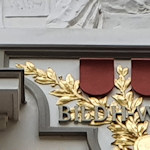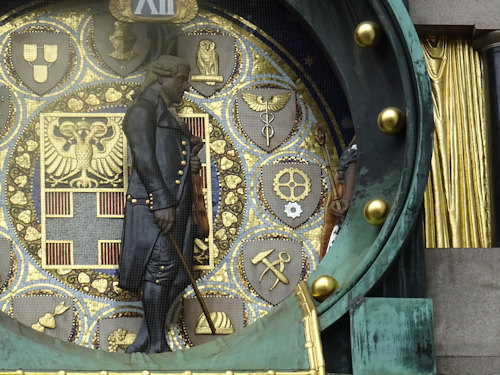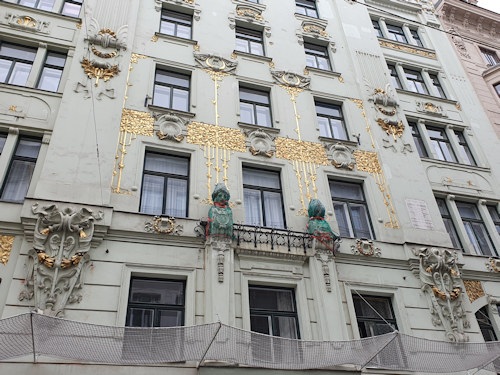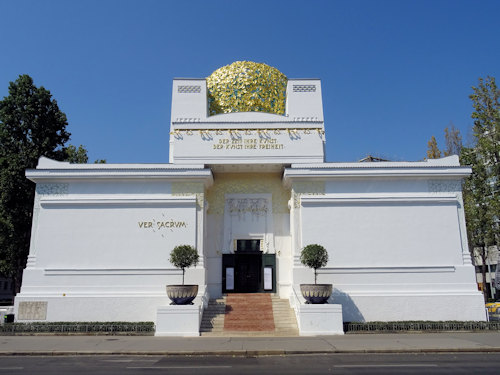
The area around the pedestrianised Graben grabs all the headlines on any walk through Vienna’s old town. But the centre has other hidden delights for those seeking a turn-of-the-century architectural thrill.
- See also:
Meat markets, clocks & post offices

(The building at Fleischmarkt 3)
A walk through Vienna’s centre normally takes you along the historical pedestrianised streets of the Graben, Kohlmarkt and Kärntner Straße. The buildings lining the route vary from the Gothic and Baroque to modern department stores.
Every few steps usually reveals a beauty or two from the time when Jugendstil design and the wider Wiener Moderne guided hands on architectural drafting boards.
In a previous article, I covered a few of these jewels from the turn of the 19th and 20th centuries on the Graben and surrounds. But now it’s time for some further highlights in the centre, if you dare take a right turn or two and leave the well-worn pavements behind.
The Ankeruhr
Go north from the mighty Stephansdom cathedral and wander up Rotenturmstraße. Continue to Lugeck square with its monument to Gutenberg and turn left down Lichtensteg to see the Ankeruhr mechanical clock at the start of Hoher Markt square.

(Haydn is one of the figures that rotates around the clock)
A life insurance company built the 1914 Ankeruhr as a contribution to the artistic heritage of Vienna, but also as a subtle reminder of the inevitability of death (thanks).
The designer, Franz Matsch, also formed part of the three-man team (alongside the Klimt brothers) that painted the famous frescoes on the staircases of the Burgtheater.
Fleischmarkt
Go back down Lichtensteg and continue up Rotenturmstraße to the next junction, where you turn right into Fleischmarkt.

(Fleischmarkt 1)
The English translation for that street is meat market, which harks back to the area’s original function back in medieval days. You won’t hear the cries of livestock today, but perhaps a few shouts of awe at the remarkable Jugendstil buildings.
It all begins on the corner at No.1, completed in 1910 by Arthur Baron. The Residenzpalast has left its cultural mark on Vienna, too. Hollywood legend, Billy Wilder, used to visit the Rotenturmkino (cinema) there, and it still houses the Kammerspiele theatre alongside the more prosaic occupants of the storefronts and offices.

(Fleischmarkt 3)
Baron also claims responsibility for the immediate neighbour at No.3 from the same year. Notable for the dark metal bay window designs, the building once echoed to the sounds of printers and screaming editors as the premises of Die Presse (still one of Austria’s more respectable newspapers).
Keep your eye on this side of the street and the remarkable façade of the Julius Meinl building at No.7, constructed in 1899.

(The Meinlhaus)
Julius Meinl is an international coffee roaster and distributor with a rich tradition in Vienna that dates back to 1862. The current HQ is within shouting distance of my house and you might spot their flagship gourmet store at one end of the Graben.
The gold lettering on the Meinlhaus reveals the building’s original purpose (English: Julius Meinl’s Coffee Import). The reliefs and coats of arms of great European trading ports reflect the international reach of the company.

(Fleischmarkt 14)
Look across the road at Fleischmarkt No.14 for another feast of golden turn-of-the-century decoration. If the ornamentation feels vaguely reminiscent of the famous Secessionsgebäude, that’s because a certain Joseph Maria Olbrich designed the latter, while the company he co-founded constructed the former.
Postsparkasse building

(Frontal view of the building from Georg-Coch-Platz)
Continue to the end of Fleischmarkt and around the block to stumble upon the huge and pioneering Postsparkasse building, former home to the Austrian Postal Savings Bank.
First opened in 1906, the Otto Wagner-designed building represents the transition from ornamental Jugendstil to a modern-era architectural approach that combines aesthetics and functionality, right down to the design of the doorknobs.
The façade sets an unusual, yet striking, tone thanks to the pattern created by aluminium rivets on marble: a pattern echoed elsewhere in buildings of the time, such as at Riemergasse 7 (also in the centre).
And finally…

(The Secession building made famous by the likes of Gustav Klimt)
These highlights and those on the Graben represent those perhaps most easily reached when drifting through the old town on typical tourist trails. But stepping outside the centre of Vienna allows you to discover one or two absolute jewels of Jugendstil architecture.
Those examples not more than a short(ish) walk away include the Majolika House with its polychromatic tiled front, the aforementioned Secessionsgebäude that played a key role in the whole Jugendstil phenomenon, Otto Wagner’s Stadtbahn stations, and Wagner’s gorgeous pavilions on Karlsplatz square.